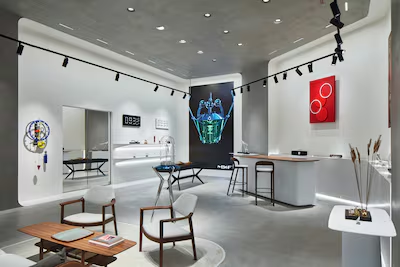“I was getting ready for Armageddon. Game over.” On March 17, 2020, Maximilian Busser, founder of niche watchmaking brand MB&F, sent his team home. Covid-19 had struck and all of the brand’s retailers had shut shop.
After spending 15 years building his company, scouring the world for clients who might share his love for unusual, highly complex (and eye-wateringly expensive) horological creations, he thought it was all over. “It felt like the end of the world. We were thinking: ‘Who is going to buy a watch ever again?’”
But then something strange started happening. In April and May 2020, even though the brand’s retailers were still closed, sales were as good as ever. In June, the brand had one of the best months in its history. And that success has continued on an upward trajectory ever since.
Busser is still grappling with the hows and whys of this unexpected development. He suspects it is because many big watchmaking brands stopped communicating with their clients during the early stages of the pandemic, while MB&F, and other like-minded independent brands, “started having incredible conversations with people online, via Instagram live and Zoom and so on”.

At the same time, the secondary market for MB&F’s pieces started growing. From 2013 to 2020, the brand had capped the number of pieces it produced to 278 per year. The complexity of the creations, which are all hand finished, and the dwindling number of artisans who are able to create them, meant they could never be produced in large volumes anyway. But their limited numbers drove demand on the secondary market and, for the first time, there was a waiting list for Busser’s unusual concepts.
The MB&F offering is split into two main collections: the more outlandish Horological Machines, kinetic sculptures that are highly technical, but also three-dimensional, defined by unexpected shapes and seemingly incongruous proportions; and the more nostalgic Legacy Machines, which actually look like watches, rather than futuristic accessories for the arm, and are Busser’s “tribute to the great creators of 200 years ago”. A Dh500,000 price tag for an MB&F piece is not unusual.
We meet in Dubai Mall, within the endlessly intriguing environs of the Mad Gallery.

Founded by Busser in 2011 and now present in Geneva, Taipei and Dubai, the galleries feature MB&F’s own timepieces, alongside a carefully curated collection of weird and wonderful kinetic and mechanical items by creators from around the world. They are the ultimate symbol of Busser’s collaborative approach.
He shows me an MN9 SV Sapphire Vision, the last in the world. Like a miniature underwater vessel transported back from the future, it features a curved and bubbled outer hull of sapphire crystal and precious metal, and is worth Dh1.7 million.
“You do not expect people lining up to try to buy this.” His voice dips slightly, the emotion audible if you listen closely enough. “That is a mechanical sculpture. That is exactly what I set about creating 18 years ago.”
The half-Swiss, half-Indian resident of Dubai was brought up through the ranks of Jaeger-LeCoultre, where he was part of the senior management team for seven years during the 1990s, and became the managing director of Harry Winston Rare Timepieces in 1998 at the age of 31.
But, 18 years ago, he decided he’d had enough. He wanted to create things that were new, innovative and pushed the boundaries of horology – rather than just corporate-endorsed designs that were only produced because they were guaranteed to sell. So he set up MB&F (the F, incidentally, stands for friends – like-minded creative geniuses who are committed to challenging industry norms).
Twenty calibres and a series of award-winning designs later, with a further ten calibres in the pipeline, Busser is clearly stunned by the brand’s success. “Pre-2020, the person who bought MB&F was an insane lover of what we do. They knew that if they tried to sell it, they would lose money. So it was pure love.
“But when secondary market prices came close to original prices, all of a sudden, we found five to ten times more people turning up at our door saying: ‘I’ve always loved what you do, but I wasn’t ready to lose money. But now, clearly, I can buy one of your pieces, and after one or two years, sell it and maybe lose five to ten per cent, and that’s acceptable.’
“As a creator, I no longer have nightmares about who the hell is going to buy my products, which is really nice. But it brings many other challenges. Suddenly, we have to start deciding who is ‘worthy’ of having our pieces, which is horrible. I never signed up for that – I’m just grateful for anybody who wants to buy one of my pieces,” he says.
Production has been upped to 345 pieces a year, but demand still far outstrips supply. Recent launches include a new version of the Legacy Machine Perpetual, which was first launched in 2015, and since been reworked in red gold, platinum, white gold, titanium, yellow gold and palladium. New to the roster is a version in steel and salmon, a first for MB&F.

The award-winning LM Perpetual is a collaboration between MB&F and independent Irish watchmaker Stephen McDonnell, which resulted in a reinvention of one of the most traditional of horological complications – the perpetual calendar. An open dial reveals the full complication and suspended balance, while subdials appear to float above the movement with no visible attachments
Increasingly, Busser’s thoughts are turning to the actual matter of legacy, which is new for him. “I want to make sure this company survives me, which was never a thought in my mind. I think in the last four or five years, especially with the scare we had with Covid … you start thinking that you don’t want all of this to go to waste.”

